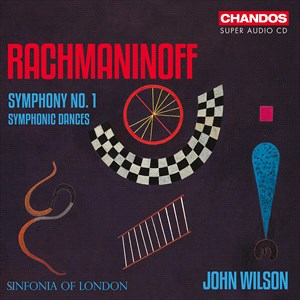

Sergei Rachmaninov (1873-1943): Symphony No. 1 in D minor, Op. 13 (1895) Sergei Rachmaninov (1873-1943): Symphonic Dances, Op. 45 (1940)
The portentous opening of the symphony is recognizably echt Rachmaninov, a symphony often given less respect in the composer's oeuvre compared to his solo piano and piano concertos, and even the later symphonies. Truth is, it's a highly enjoyable piece, and like the other symphonies, very easy on the ear. Indeed, composer Robert Simpson thought it the best of the three symphonies. Famously, this symphony caused the composer great mental anguish after a disastrous first performance, and he attempted to destroy it, the first performance reconstructed from notes after his death.
I am so pleased we have a recording here of the bookends of Rachmaninov's orchestral music career, completing Wilson's exciting cycle of the orchestral music. Pairing the wonderful late Dances with the 1st symphony I hope encourages more people to hear the early work than might otherwise. A theme from the Symphony's 1st movement is used in the Dances, so there is a link with his earlier work, but there are not many couplings like this, although the recent 2021 release with the Philadephia Orchestra under Yannick Nézet-Séguin is also a winning option.
Throughout his symphony cycle, Wilson has seemed very much at home in the Rachmaninov idiom, avoiding the periodic temptation to wallow, while playing up the romantic sweeping melodic lines and often exciting, sometimes lugubrious, climaxes. Case in point, the first climax in the 1st movement of the symphony. The strings are placed well forward, and clearly recorded to capture the fugal development distinctly, the tempo fast enough but not with undue haste. The string winding lines near the start of the third movement are similarly carefully molded. The final movement is sometimes a challenge, it can seem episodic, with the exciting opening theme setting high expectations, but not itself developed. Here, the momentum is maintained right to the final notes.
In the Dances the composer incorporates rich orchestral colors throughout, most famously the solo alto saxophone part, but also harp, piano, glockenspiel, tubular bells and xylophone. This last completed work, for me, is his finest orchestral work. The trademark elements are all there, but brought into a tight three movement format, yet scored with a formal freeness not available in the symphonic form. The dance format seemed to give the composer creative room to breathe, the three movements reflecting a gradual progress from a rhythmically alert Midday, through a ghostly waltz for Twilight, and finally the Dies Irae confrontation in the finale.
Wilson and his London Sinfonia maintain the high standards of recording and playing from their previous releases. There are several excellent alternative cycles, several from Russian forces that sometimes add a certain traditional Slavic sound and spirit (e.g. Svetlanov, Petrenko), excellent non-Russian options include those from Slatkin (Detroit Symphony Orchestra, recently re-released in the Vox Audiophile series), early stereo Maazel with the Berlin Phil, Ashkenazy in multiple versions, Previn (to the manner born in this music).
For those interested in this specific coupling, it does face significant competition from Yannick Nézet-Séguin and his Philadelphia Orchestra in a 2021 release, the richness and emotion of the string playing seeming to reach the heights of that under Ormandy (who conducted the US premiere with its dedicatee, the Philadelphia Orchestra). The saxophonist in Philadelphia does a wonderful job with the famous solo in the 1st movement.
In the end, I would be very happy to take this release and Wilson's cycle overall. There are no distracting extremes, and a natural feel for the rich orchestral color, the heart on sleeve melodic invention, and the exciting faster sections. A thoughtful program beautifully played and clearly recorded.
Ian Orbell - May 2025 Symphony No. 1 - Final Movement